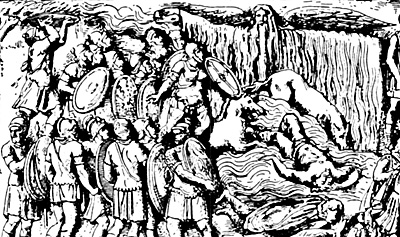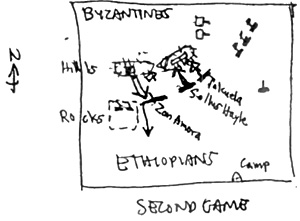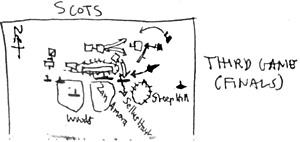 Background
Background
At then local SIMCOM wargaming convention, held in Rochester, New York, in March 1987, an ancients tournament was run under the auspices of SAGA, with Dave Armer as Chief Umpire. Battles were fought under the Wargames Research Group 7th Edition rules; including the official amendments recently published in the Courier. Each player supplied his own 15mm, 1250-point army from any book off the WRG official lists. Besides the armies mentioned below, other entries included Late Romans, Alexandrian Imperials, Rormans, Bactrian Greeks, Spanish Visigoths, Nikephoran Byzantines, and Mongols.
For the 12 entrants, there were two qualifying rounds against different opponents; with the two highest point totals meeting in the finals? I won the tournament while using a newly-painted Ethiopian army of 1329 AD (From list 101, Abyssinian) as follows:
- CinC The Negus Amda Seyon(Pillar of Zion), with 2 guards; Irregular B class, extra heavy cavalry, javelin and shield(EHC, JLS, sh)
Subgeneral Ya'akel Gada, with guard, 1 light cavalry (LC), Irr B, JLS, sh
Regiment Giyorgis-Hayle (Strength in St George); 6 EHC, JLS, sh, Irr B
Regiment Abrigima (geographical district). 9 heavy cavalry (LC) Irr B, JLS, sh
Regiment Sawaryana Warmat (Carrier of Spears). 12 LC, Irr B, JLS, sh
Regiment Takuela (Jackals): 24 light medium infantry (LMI), Irr A (fanatic) JLS, sh
Regiment Sellus Hayle (The Trinity is My Strength). 24 Irr A, LMI, JLS, sh
Regiment Bedel Sabraq (Sun in Victory) 12 LMI, Irr A, JLS, sh
Regiment Zan Amora (Lord of the Vultures) 36 LMI, Irr C, JLS, sh
Regiment Querban Heywate (Living Sacrifice): 12 light infantry (LI) Irr C, JLS, sh
Regiment Badel Mabraq (Lightning in Victory). 12 LI, Irr C, JLS, sh
Regiment Qasta Neheb (Bow/Sting/Arrow of the Bee) 16 LI, Irr C, bow
1 section of camp; guarded by Regiment Yesaweru Walta (They Carry a Shield) 6 LMI, Irr C, JLS, sh
As the list shows, this army suffers from a lack of long range weapons, but it has a small amount of good cavalry and its real strength lies in the Irregular A fanatic infantry. The latter receive a special melee-bonus; but only when they roll positive on the dice (so that when they are good, they're very, very, good, but when they roll down...)
Moreover, the "impetuous" charges frequently mention below give a separate bonus in melee--at fatigue cost--to irregulars such as the Ethiopians--a considerable drawback under the 7th Edition is that LMI and LI (that is, the Ethiopian foot) who are charged by cavalry have to take a "waver" (morale) test. If the LMI or LI fail, they become shaken and should be badly beaten by a cavalry charge delivered with any force. Another problem is that in hand-to-hand combat, irregular foot such as the Ethiopians in effect take double casualties."
II. FIRST GAME: QUALIFYING R0UND
My opponent, Mark Bloom, used List 82, Sub-Roman British (that is British armies after the Romans left). Except for a few foot archers, the British were largely divided between (1) large numbers of LMI with JLS, variously classed as Irregular C and Regular D, and (2) several units of good Irregular B heavy cavalry. It was a fair and open battle in good weather. The British took the near end of the game table. The dominating terrain features, as far as the game was concerned, lay in the middle: a rocky patch on the west flank; a steep hill and small woods on the east flank; and a large woods in the east slightly towards the British side, between the hill and the British end line.
As the Ethiopian advance began, Querban Keywate crept into the rocky patch. Immediately to their right, in the open west center was the Ethiopian cavalry. The bulk of the Ethiopian infantry stretched from west center to the woods, while Badel Mabraq headed over the hill and towards the large woods.
Bloom later explained that his plan was to have his HC annoy the Ethiopians and cause then to halt, thus giving the infantry time to come up. This did not work: Three British units of cavalry duly advanced. Two of the units got too close to the Ethiopian LMI, who charged impetuously. The cavalry countercharged, but impetuous infantry do not have to halt their own charge.
In the first round, one British unit was forced to recoil by Sellus Hayle. The other pushed Zen Amora back. This effort failed in round two as Takuela attacked the successful cavalry locked in contact in the flank, and routed them. The shock caused the first cavalry unit to fail a waver test. Since the cavalry comprised a 2-unit command under 1 subgeneral, and both were shaken or routed, the command became demoralised and the cavalry headed for the rear.
Meanwhile, further west, the-third British unit charged Sawaryana Warmat and forced those light cavalry to evade back. While the British were rallying, Badel Sabraq came up; charged them impetuously, and routed them.
Because both sides' infantry moved relatively slowly, and the British had to rally several units who were shaken because the center routed, that was about it for the battle. One British LMI unit had been observing Badel Sabraq and Qasta Neheb in and near the large woods. On the last turn before time expired, Takuela managed to charge the LMI in the flank and shake (but not rout) the unit.
- Total Points:
Ethiopians: 599
British--0
 SECOND GAME BY QUALIFYING ROUND
SECOND GAME BY QUALIFYING ROUND
My opponent, Rich Kohlbacher had a Maurikian Byzantine army (List 91, 600 AD). This contained' several separate foot archer units and some skutatoi (heavy infantry with, long thrusting spear-LW). But the main force of the army was its 12-man cavalry units of 6-man front rank EHC with lance and bow and 6 back-rank HC with lance and bow.
It was a fair and open battle in good weather. The Byzantines were at the "north end." There was a rocky patch in the west middle, but he rolled up two gentle hills in the west, just forward of his set on line. The second hill angled slightly to his rear, creating a f1shhook effect and the backbone of the Byzantine defense. They dismounted most of their cavalry and together with some of the skutatoi formed on the crests of the hills. The archers, clearly hoping to soften the Ethiopians up, were thrown forward slightly.
The open gap between the eastern most hill and the Byzantine rear was covered (initially} by one unit of skutatoi and one of a cavalry unit which remained mounted up an then awaited the Ethiopian advance.
This took a while. Under the 7th Edition, even unopposed LMI do not march quickly. Querban Heywate and Badel Mabraq disappeared into the rocky patch. The cavalry, followed by Badel Shabraq, which as LMI lagged behind, made a long sweep to the east, in an attempt to threaten the hill rear gap. Qasta Neheb tried to get off some bow shots but, as the Ethiopians approached, was squeezed out of line. The bulk of the Ethiopian LMI headed for the hills. Zan Amora went to the west center, Sellus Hayle and Takuela opposite the easternmost hill Sellus Hayle charged, contacted, and routed a Byzantine LI unit which picked the wrong time to roll the dice for a short evade move. That put Sellus Hayle at the foot of the east hill. The rest of the Ethiopians tried to come up, but in the process of wheeling, only Takuela came close enough. Zan Aurora lagged.
That bound showed what happens when you use an irregular army. In the west, the Byzantines remounted one cavalry unit. It charged Zan Amora, starting from outside the Ethiopian charge range. Zan Amora failed its waver test and 36 LMI were routed by a cavalry unit with a 6-man frontage. Moreover, nearby Badel Mabraq failed its own waver test caused by the rout, so that both regiments and the now unsupported Querban Heywate were forced to hide in or near the rocks.
In the east, however, both Sellus Hayle and Takuela charged impetuous uphill into a dismounted cavalry and a skutatoi unit, respectively. Both rolled a plus 3 in melee, and each had an extra plus 2 for being Irregular A. The results: the Byzantine advantage of bows and long spears and hill were negated, and both Byzantine units routed. By the time the chain of morale rolls was complete, 5 of the 7 Byzantine units (including the previously routed LI) and one general's command were either shaken or routing. Under the 7th Edition, this demoralized the command and gave it mandatory retreat orders. Since the back line was so near, the orders were quickly carried, out for most of the units.
The Byzantines made a valiant effort to recover, but, with the retreat on, did not have the men. Slowly and successively, even victorious Byzantine units were caught in front and flank and routed. Eventually, the entire Byzantine army was destroyed or driven from the field.
- Total Point
Ethiopians--880
Byzantines--233
- (The Ethiopians did not get 1250 because under the 7th Edition amendments, some classes of off-board enemy units in effect only count at half value)
 IV. THIRD GAME FINAL ROUND
IV. THIRD GAME FINAL ROUND
My opponent, Bob Averill, had a Pre-Feudal Scottish army (List 111 circa 1000 AD). The main strength of the Scots lay in large blacks of Irregular C medium infantry spearmen (MI) with LTS. Besides a few LI (archers and jaaelins), the Scots also had, (1) 2 units of 12 HC, and, (2) a Highland Ally General and several units of Hllghland infantry--each with a front rank of 6 Irregular A LMI JLS, sh, and a back rank of 3 Irregular C, LMI, JLS, sh, and 3 LMI with bows. The primary effects of mixing morale clases were that the front rank fought as fanatic Irregular, but, on morale rolls, the unit responded as ordinary Irregular C.
It was a fair and open battle in good weather. The Scots were at the "north end." The Ethiopians drew our their side of the table, two large woods in the center and a steep hill in the east. A reroll managed to roll up a gentle hill on the Scottish side, and on this hill he promptly anchored a solid line of MI. One unit of HC and one unit of LI were posted on each flank. The highlanders were mainly in reserve.
For the Ethiopians, the LI regiments Querban Heymate and Badel Mabraq advanced in the west, one inside and one just west of the woods and covered the flank, where they skirmished indecisively for the rest of the game. Takuala and Zan Amore came up through the woods, but under the 7th Edition, even LMI can have trouble marching in woods and they lagged. Further east, Sellus Hayle moved up im the gap between the woods and the steep hill, while Qasta Neheb came over the hill. Finally, the Ethiopian cavalry, followed slowly by Badel Shabraq, made a wide, on-table sweep to get around the Scottish east flank.
Here the Scots made a mistake. Although the eastern LI unit was pinned by Sawaryana Warmat's LC and could not prevent the other two Ethiopian cavalry units from completing the turn, the Scottish HC still moved out and too far. When Averill realized this, he ordered the HC to turn and close up towards the main army, but irregulars do not make that maenuver very quickly in the 7th Edition.
The Ethiopian HC Abrigima ordered an impetuous charge at the backs of the HC. Hbwever, the edge of their formation contacted the Scottish LI, and Averill, instead of ordering the Scots to make the normal evade, had them stand. They failed a waver test, and were destroyed in one round, but they had achieved their purpose. Abrigima did make contact on the HC, but as tired, the Scots eventually turned around, and the result was an indecisive cavalry melee for the rest of the battle.
The crucial point became the joint of the Scottish line at the east end of the hill, where the solid line of MI ended. Sellus Hayle and a newly-arrived unit of Highlanders charged each other impetuously. The Ethiopians rolled minus 2, the Scots plus 4, and Sellus Hayle routed. This in turn caused nearby Zan Amore, which had just emerged from the woodsy to fail a waver test and become shaken.
What saved the Ethiopians was that in trying to get through the woods, Zan Amora had gone into the easy-to-retreat skirmish formation. Thus the Scottish MI were in position to catch the regiment before it faded back into the woods. There Zan Amora was eventually rallied to normal status by CnC Adda Seyon, but took no further part in the battle.
Meanwhile, in the second, round of melees, the pursuing Highlanders hacked at the backs of fleeing Sellue Hayle and destroyed the unit. That same bound, however the Scots were themselves charged in the flank by Sawaryana Warmat, failed a waver test, became shaken and fell back sideways. This allowed Sawaryana Warmat to push the Highlanders back again on the next turn, whereupon they failed a second waver test and were routed. However, Sawaryana Warmat was in turn charged in the flank by a unit of Scottish archers (all he had available), pinning the Ethiopians.
Next, the Scots did something nobody present--players, umpire, or spectators--had ever, seen tried under 7th Edition. They tried to replace the archers in combat. It was eventually ruled that the Highlanders were entitled tb a charge but both units were disordered. This did not matter to the Highlanders. Sawayana Warmat failed in its die roll to turn and face the Scots, and were routed by them.
To the north, the Scots had filled the gap between the hill and their rear line with one unit of MI and one unit of Highlanders. Badel Sabreq finally came up, and charged the MI impetuously without decisive result. As game time ran out, Giyorgis Hayle's EHC began a charge on the Highlanders from beyond the Highland move range. The Scots failed a waver test, and Giyorgis Hayle routed them. This in turn caused another small Scottish unit to fail a test of its own and become shaken, and the game ended.
- Total Point
Ethiopians--282
Scots--254
Back to Saga # v2n2 Table of Contents
Back to Saga List of Issues
Back to MagWeb Magazine List
© Copyright 1987 by Terry Gore
This article appears in MagWeb.com (Magazine Web) on the Internet World Wide Web. Other articles from military history and related magazines are available at http://www.magweb.com